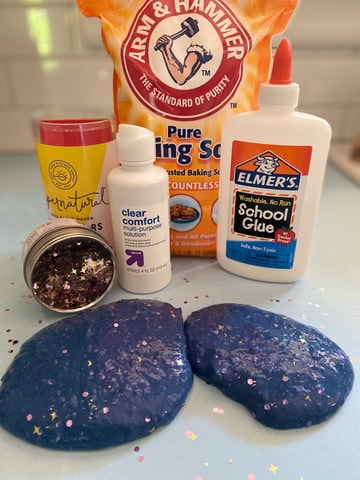Discover the Joy of Slime Making: A Parent’s Ultimate Guide
Hello, wonderful parents out there! Are you ready to dive into the squishy and mesmerizing world of slime with your kids? Making slime is not only a fun activity that will keep your little ones entertained, but it also incorporates elements of science, creativity, and sensory play. As your cheerful guide, I’ll walk you through the basic ingredients and steps to create your very own batch of homemade slime. So, let’s get our hands sticky and our minds curious as we explore the ins and outs of slime-making together!
Essential Slime Ingredients: What You’ll Need
Before the fun begins, you’ll need to gather your materials. Most slime recipes consist of simple household items, but each type of slime may require a slight variation. Here are the foundational ingredients you’ll need:
- Glue: This is the base of most slime recipes. White PVA glue (school glue) works best, but you can also use clear glue for a translucent effect.
- Borax Solution: A mixture of water and borax powder acts as an activator, transforming glue into slime. However, since borax can be harsh on sensitive skin, there are alternative activators we’ll discuss later.
- Water: Some recipes require additional water aside from what’s mixed with the borax.
- Coloring: Food coloring, paint, or even pigments can be used to add a pop of color to your slime.
- Add-ins: Want to jazz up your slime? Consider glitter, scented oils, foam beads, or even glow-in-the-dark paint for extra fun.
Basic Slime Recipe: The Classic Method
Now that you’ve got your ingredients lined up, let’s start with a simple recipe for classic slime:
- Mix 1 teaspoon of borax powder with 1 cup of warm water to create your activator solution. Stir until fully dissolved.
- In a separate bowl, mix together 1/2 cup of PVA glue with 1/2 cup of water. Stir until well combined. If you’re going to add food coloring or other color agents, now’s the time!
- Slowly, add the borax solution to the glue mixture, stirring continuously. You’ll notice the slime beginning to form.
- Keep stirring until the slime pulls away from the sides of the bowl and starts to clump together in the center.
- Remove the slime from the bowl and knead it with your hands until it reaches the desired consistency. If it’s too sticky, you can add a bit more activator.
Congratulations! You’ve just made your very first batch of basic slime. But wait, there’s more! With endless varieties and techniques, you can customize your slime in so many ways. Let’s explore a few more recipes and safety tips to make your slime adventure successful and safe.
Additional Slime Recipes: Variations to Try
Once you’ve mastered the basic recipe, there’s a whole world of slime variations to explore. Some popular types include:
- Fluffy Slime: By adding shaving cream to your glue mixture, you’ll create a lighter, fluffier texture that is super fun to squish!
- Butter Slime: Adding modeling clay to your slime recipe gives it a velvety, spreadable texture, just like butter.
- Edible Slime: Concerned about little ones who might put slime in their mouths? Opt for edible slime recipes using ingredients like cornstarch and food-safe coloring.
Slime Safety Tips for Parents
Safety is paramount when making slime with your children. Here are some tips to keep the fun safe:
- Always supervise children during slime play, especially those under the age of 6.
- Wear protective gear like gloves if you have sensitive skin or are allergic to any ingredients.
- Keep slime ingredients and the finished product away from pets to avoid accidental ingestion.
- Be aware of the ingredients in your slime, and choose non-toxic, kid-friendly options whenever possible.
- Store slime in an airtight container to keep it fresh and prevent it from drying out or getting dirty.
Slime-making can be a wonderful bonding experience for parents and children alike. It encourages learning, creativity, and the development of fine motor skills. As you continue on your slime journey, remember to have fun, experiment with new recipes, and let your children’s imaginations run wild. With these tips and recipes, you’re well on your way to becoming slime experts!
Stay tuned as our guide continues to delve into the nitty-gritty of slime making, including a plethora of recipes, troubleshooting tips, and creative ideas to enhance your slime experience. Get ready to explore a slimy world of limitless possibilities and joyous adventures ahead!

Five Things Parents Should Know Before Making Slime
As the slime trend continues, it’s essential for you as parents to know a few things to make sure your slime-making experience is as enjoyable as possible:
- Understanding the Science: Explain to your children how slime is a type of non-Newtonian fluid and how the chemical reaction between the glue and the activator works. This not only makes the experience educational but also adds an element of wonder as they witness science in action.
- Preparation is Key: Ensure you have a clean workspace and all necessary materials on hand before starting. Cover surfaces with newspaper or plastic for easy cleanup, have paper towels ready for spills, and wear old clothes that can get messy.
- Quality of Ingredients: The quality of your ingredients matters. For example, the type of glue used can affect the texture and stretchiness of your slime. PVA glue is recommended because it creates a great consistency. Always check for any recalls or safety warnings on slime ingredients you plan to use.
- Activator Options: If you’re hesitant to use borax due to skin sensitivity concerns, there are alternatives. You can use liquid starch, saline solution (containing boric acid and sodium borate), or contact lens solution as an activator. These might be gentler on the skin while still providing excellent results.
- Patience and Experimentation: Making the perfect slime may take a few tries. The consistency can change depending on various factors like humidity and the ratio of ingredients. Encourage your kids to experiment with measurements and to be patient as they learn the best method for making slime that they love.
Advanced Tips and Tricks for Slime Perfection
Once you’ve gotten the hang of the basic recipes, here are some advanced tips for stepping up your slime game:
- Slime Softeners: If your slime becomes too tough or rubbery, you can add a slime softener such as glycerin or lotion to make it stretchy again.
- Air Bubbles: To achieve bubble-filled, sizzly slime, let your slime sit in an airtight container for a couple of days. The formation of air bubbles will give your slime a crunchy texture and enjoyable sound when played with.
- Temperature Effects: Slime’s texture can change with temperature. Warm it up in your hands for stretchier slime, or refrigerate it for a firmer consistency.
- Color Layering: For a rainbow effect, create slim slayers with different colors and carefully lay them on top of each other. Stretch and fold gently to see a beautiful swirl of colors.
- Treating Stains: If slime gets on clothing or fabric, rubbing alcohol or vinegar can help remove the stains. It’s best to treat any spills immediately to prevent them from setting.
With this comprehensive guide, you’re equipped with the knowledge to embark on a slime-making journey filled with education, creativity, and fun. Enjoy those priceless moments with your kids, embrace the mess, and create memories that will stick just like that gooey masterpiece you’re about to whip up together!
Remember, slime-making is more than just a craft; it’s an opportunity to engage with your kids and teach them valuable skills. And who knows? You just might find yourself having as much fun as they are. Happy slime-making!
See more great Things to Do with Kids in New Zealand here. For more information see here
Disclaimer
The articles available via our website provide general information only and we strongly urge readers to exercise caution and conduct their own thorough research and fact-checking. The information presented should not be taken as absolute truth, and, to the maximum extent permitted by law, we will not be held liable for any inaccuracies or errors in the content. It is essential for individuals to independently verify and validate the information before making any decisions or taking any actions based on the articles.




